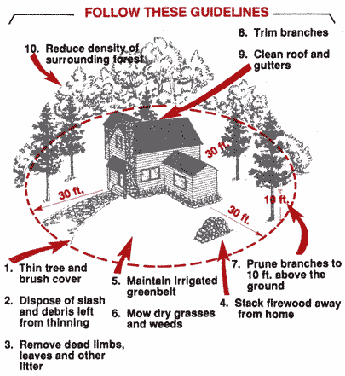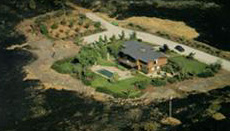Defensible Space
 When people live in a high fire hazard environment, the human built environment becomes an important factor in predicting the loss of life and property. Untreated wood shake and shingle roofs, narrow roads, limited access, lack of fire-wise landscaping, inadequate water supplies, and poorly planned subdivisions are examples of increased risk to people living with the threat of wildfire. The diagram below illustrates fire-wise landscaping techniques that result in defensible space around your home and community.
When people live in a high fire hazard environment, the human built environment becomes an important factor in predicting the loss of life and property. Untreated wood shake and shingle roofs, narrow roads, limited access, lack of fire-wise landscaping, inadequate water supplies, and poorly planned subdivisions are examples of increased risk to people living with the threat of wildfire. The diagram below illustrates fire-wise landscaping techniques that result in defensible space around your home and community.
Defensible space increases the moisture content of vegetation and decreases the amount of fire fuels. Removal of dead wood, low hanging branches, plants and shrubs bellow taller trees decreases "ladder fuels" which enable a fire to spread.
 Under extreme conditions, almost any house can burn no mmatter what the mix of building materials that make up the building happen to be. However, having a defensible space surrounding the building significantly improves the odds of your home surviving a wildfire.
Under extreme conditions, almost any house can burn no mmatter what the mix of building materials that make up the building happen to be. However, having a defensible space surrounding the building significantly improves the odds of your home surviving a wildfire.
Vegetation in the mountain areas has evolved in a wet/dry cycle; wet winters and springs, with dry summers and falls. This means the health in general of the environment that may make up the area around your property should be relatively good in terms of clearance and healthy vegetation that is able to withstand isolated small pockets of naturally ignited fires.
Excessive watering around native trees during these normally dry periods will create wet soil, allowing root disease to develop on the tree root and the trees become weakened and may be killed by insects of susceptible to being blown down.To protect your trees from insects, disease and wind damage, guide and protect them with care.